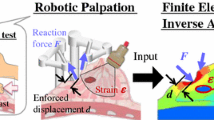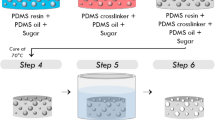Abstract
Palpation is an economical, safe and effective method to detect breast cancer among other expensive and sometimes limited diagnostic tools such as mammography and magnetic resonance imaging (MRI). To understand the mechanics of palpation, a rigid inclusion was embedded in a phantom gel to simulate the lesion. An array of indents using a rigid indenter was made over an assigned area of the phantom surface, while the applied load, F, was measured as a function of instantaneous indentation depth, w. When the local stress field interacted with a sufficiently shallow inclusion, the mechanical response F(w) yielded an augmented apparent stiffness C. A 2-dimensional spatial map of C shows the presence, depth, and geometry of the simulated lesion. A camcorder was used to capture the in-situ movement of the inclusion during indentation, which showed consistency with the finite element (FEA) prediction. Results provide preliminary confirmation that mechanical indentation is a good tool to complement existing imaging techniques and has the potential to guide design and fabrication of an automatic palpation device.






Similar content being viewed by others
Notes
Video tracking software: ANchOVy, Comprehensive Software Suite for the Annotation of Objects in Videos, 2012. Authored by Oliver Lehmann, Octavia Camps, Richard Moore, and Gilead Tadmor, Northeastern University, Boston MA 02115. Contact anchovy.team@gmail.com
References
Smith RA, Duffy SW, Gabe R, Tabár L, Yen AM, Chen TH (2004) The randomized trials of breast cancer screening: what have we learned? Radiol Clin N Am 42(5):793–806
White E, Lee CY, Kristal AR (1990) Evaluation of increase in breast cancer incidence in relation to mammography use. J Natl Cancer Inst 82:1546–1552
Kopans DB (2002) Beyond randomized, controlled trials: organized mammographic screening substantially reduces breast cancer mortality. Cancer 94:580–581
Tabar L, Vitak B, Tony HH, Yen MF, Duffy SW, Smith RA (2001) Beyond randomized controlled trials: organized mammographic screening substantially reduces breast carcinoma mortality. Cancer 91:1724–1731
Duffy SW, Tabar L, Chen H, Holmqvist M, Yen M, Abdsalah S, Epstein B, Frodis E, Ljungberg E, Hedborg-Melander C, Sundbom A, Tholin M, Wiege M, Akerlund A, Wu H, Tung T, Chiu Y, Chiu C, Huang C, Smith RA, Rosen M, Stenbeck M, Holmberg L (2002) The impact of organized mammography service screening on breast carcinoma mortality in seven Swedish counties. Cancer 95:458–469
Otto SJ, Fracheboud J, Looman CWN, Broeders MJM, Boer R, Hendriks JNHCL, Verbeek ALM, de Koning HJ (2003) Initiation of population-based mammography screening in Dutch municipalities and effect on breast-cancer mortality: a systematic review. Lancet 361:411–417
van Schoor G, Moss SM, Otten JD, Donders R, Paap E, den Heeten GJ, Holland R, Broeders MJ, Verbeek AL (2011) The National Evaluation Team for Breast Cancer Screening. Increasingly strong reduction in breast cancer mortality due to screening. Br J Cancer 104:910–914
Otto SJ, Fracheboud J, Verbeek AL, Boer R, Reijerink-Verheij JC, Otten JD, Broeders MJ, de Koning HJ (2012) the National Evaluation Team for Breast Cancer Screening. Mammography screening and risk of breast cancer death: a population-based case–control study. Cancer Epidemiol Biomarkers Prev 21(1):66–73
Swedish Organised Service Screening Evaluation Group (2006) Reduction in breast cancer mortality from organized service screening with mammography: 1. Further confirmation with extended data. Cancer Epidemiol Biomarkers Prev 15:45–51
Hellquist BN, Duffy SW, Abdsaleh S, Björneld L, Bordás P, Tabár L, Viták B, Zackrisson S, Nyström L, Jonsson H (2011) Effectiveness of population-based service screening with mammography for women ages 40 to 49 years: evaluation of the Swedish Mammography Screening in Young Women (SCRY) cohort. Cancer 117(4):714–722
Coldman A, Phillips N, Warren L, Kan L (2007) Breast cancer mortality after screening mammography in British Columbia women. Int J Cancer 120(5):1076–1080
Feig S (1995) Estimation of currently attainable benefit from mammographic screening of women aged 40–49 years. Cancer 75:2412–2419
Kopans D (2006) Breast Imaging, 3rd edn. Lippincott Williams & Wilkins, New York
Mariappan YK, Glaser KJ, Ehman RL (2010) Magnetic resonance elastography: a review. Clin Anat 23(5):497–511. doi:10.1002/ca.21006
Han L, Noble JA, Burcher M (2003) A novel ultrasound indentation system for measuring biomechanical properties of in vivo soft tissue. Ultrasound Med Biol 29(6):813–823
Radicke M, Mende J, Kofahl A, Wild J, Ulucay D, Habenstein B, Deimling M, Trautner P, Weber B, Maier K (2011) Acoustic radiation contrast in MR images for breast cancer diagnostics—initial phantom study. Ultrasound Med Biol 37(2):253–261. doi:10.1016/j.ultrasmedbio.2010.11.005
Mahoney L, Csima A (1982) Efficiency of palpation in clinical detection of breast cancer. Cancer Med Assoc J 127(8):729–730
Goodson WH III, Hunt TK, Plotnik JN, Moore DH II (2010) Optimization of clinical breast examination. Am J Med 123(4):329–334
Madsen EL, Frank GR, Krouskop TA, Varghese T, Kallel F, Ophir J (2003) Tissue-mimicking oil-in-gelatin dispersions for use in heterogeneous elastography phantoms. Ultrason Imaging 25:17–38
Lai JCY, Soh CB, Gunawan E, Low KS (2010) Homogeneous and heterogeneous breast phantoms for ultra-wideband microwave imaging applications. Prog Electromagn Res 100:397–415
Yegingil H, Shih WY, Shih W-H (2010) Probing model tumor interfacial properties using piezoelectric cantilevers. Rev Sci Instrum 81:095104. doi:10.1063/1.3482055
Yegingil H, Shih WY, Shih W-H (2007) Probing elastic modulus and depth of bottom-supported inclusions in model tissues using piezoelectric cantilevers. Rev Sci Instrum 78:115101. doi:10.1063/1.2793502
Johnson KL (1985) Contact Mechanics. Cambridge University Press, Cambridge
Maugis D (2000) Contact, Adhesion and Rupture of Elastic Solids. Springer, New York
Eshelby JD (1957) The determination of the elastic field of an ellipsoidal inclusion, and related problems. Proc R Soc Lond A 241:376–396
Krouskop TA, Wheller TM, Kallel F, Garra BS, Hall T (1998) Elastic moduli of breast and prostate tissues under compression. Ultrason Imaging 20:260–274
Yan W, Pun CL, Wu Z, Simon GP (2011) Some issues on nanoindentation method to measure the elastic modulus of particles in composites. Compos Part B 42:2093–2097
Acknowledgments
Massachusetts General Hospital is acknowledged for funding LS, SM, FQ, and KT, and the Northeastern University Gordon Scholars Program for providing a stipend for SM. Partial support for JS and KTW by the US National Science Foundation is also acknowledged. Any opinions, findings, and conclusions or recommendations expressed in this material are those of the authors and do not necessarily reflect the views of NSF.
Author information
Authors and Affiliations
Corresponding author
Rights and permissions
About this article
Cite this article
Sallaway, L., Magee, S., Shi, J. et al. Detecting Solid Masses in Phantom Breast Using Mechanical Indentation. Exp Mech 54, 935–942 (2014). https://doi.org/10.1007/s11340-013-9786-6
Received:
Accepted:
Published:
Issue Date:
DOI: https://doi.org/10.1007/s11340-013-9786-6




